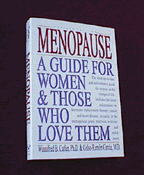Bone Health and the Menopausal Years -
Copyright ©2007 Menopause: A Guide for Women & Those Who Love Them
Winnifred B. Cutler, Ph.D., Celso Ramon-Garcia, M.D.

An excerpt for all women on Bone Health during the Menopausal Years from the book by Winnifred Cutler, Ph.D. Menopause: A Guide For Women & Those Who Love Them
Bone Health and the Menopausal Years
(Excerpt from Chapter 4 - The Bones and How They Grow)
Your Need for Calcium
Studies have shown that when you reach your perimenopausal years, your need for calcium is likely to increase. The reason is complex. Less of the dietary calcium gets absorbed into the body from the digestive tract as people get older. Young people who eat less than the optimal amounts of calcium-rich foods appear to have a 'fail-safe system” for increasing calcium absorption of the foods they do ingest. Vitamin D. (specifically the form called 1, 25, OH2D) comes to the rescue by (so to speak) extracting the calcium passing through the intestines. The vitamin D increases the rate of transfer (uptake) of the calcium from the intestines into the body. Once the calcium passes across the walls of the intestines, it enters the blood stream and travels through the body like hormones do when traveling in blood. When people get older, this fail-safe backup system becomes less efficient.
If you are menopausal, the RDA (recommended daily allowance) for calcium given by the Food and Drug Administration is probably too low for you.
****
Your Need for Exercise and Good Posture
Because bone is vital tissue that is constantly building up and breaking down, it is important to know that the way you sit and stand will affect the way your bones shape themselves. If you sit slumped, your bones will grow that way. If you sit straight, your bones will grow that way. If you stand tall and walk with an erect posture, your bones will have a tendency to be straighter than if you slouch. Exercise has profound effects on the strength and integrity of bones.